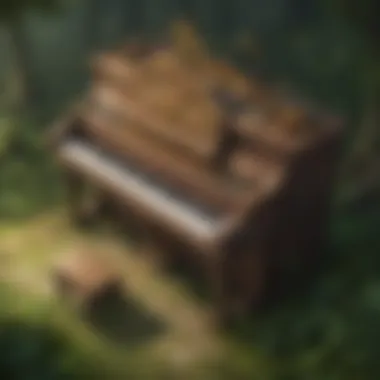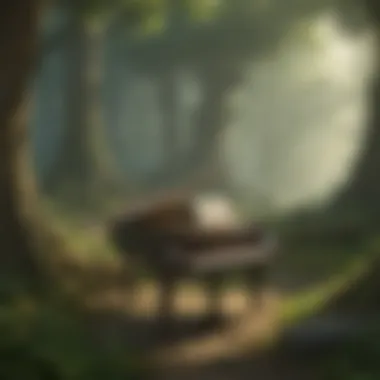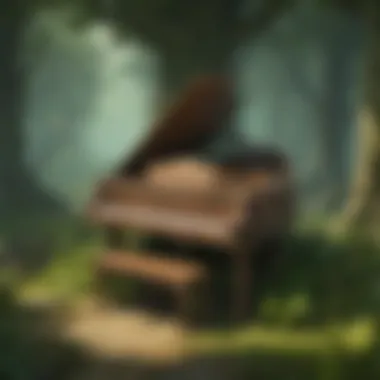Mastering the Lost Woods Theme for Piano Beginners


Intro
The 'Lost Woods' theme is one of the most recognizable pieces in the Zelda franchise. This melody not only sets the tone within the game but also resonates with fans outside of it. For beginners looking to explore this delightful piece on piano, understanding its structure and emotional depth is crucial.
Though it may seem like a simple tune, the thematic elements reflect a rich cultural background. The 'Lost Woods' theme captures the sense of exploration and nostalgia, ideal for budding musicians. This guide aims to assist those with little experience, breaking down techniques and providing insight into the music's composition.
Prolusion to the Lost Woods Theme
The Lost Woods theme holds a significant place within the Zelda franchise, capturing the imagination of fans with its enchanting melodies. Understanding this theme is essential for both pianists and enthusiasts as it embodies both nostalgia and musical complexity. For beginners, the theme represents not only a joyful challenge but also an opportunity to connect with the broader lore of the Zelda universe.
Overview of the Lost Woods
The Lost Woods consists of various musical phrases that create an ethereal atmosphere. This locale is often depicted as a mystical forest location, characterized by a labyrinthine environment where travelers may find themselves lost if they stray from the right path. The music reflects this theme of exploration and uncertainty, weaving a sense of adventure and the unknown. The melodies playfully juxtapose simplicity with intricate motifs, appealing to novice players while offering layers for more experienced musicians.
Importance in the Zelda Series
The Lost Woods theme is pivotal in adding depth to the Zelda narrative. It provides context and enhances the environmental storytelling of the game. Fans of the series often recognize this music as a hallmark of their gaming experiences. As players journey through the Zelda world, the theme resonatest, making encounters more memorable. It is not merely a backdrop but rather enhances emotional engagement within the gameplay.
Additionally, the Lost Woods theme has been covered and remixed in various Zelda adaptations, further solidifying its importance in both the game’s score and the hearts of players. This musical piece serves as a conduit for rediscovering the realm of Zelda, offering rich layers that make it a rewarding piece to learn on the piano.
Musical Structure of the Lost Woods Theme
The musical structure of the Lost Woods theme plays a crucial role in understanding its appeal and depth. For beginners, grasping these elements not only enhances performance but also deepens appreciation for the music. Each component contributes to the overall feel and character of the piece, allowing musicians to evoke the enchanting atmosphere of the game. Delving into melodic elements, harmonic progressions, and rhythmic patterns offers valuable insights into crafting an authentic interpretation.
Melodic Elements
The melody of the Lost Woods theme is both captivating and intricate. It features a singable line that many players recognize instantly. Its structure includes various motifs or phrases that repeat and develop throughout the piece. This repetition creates familiarity, allowing beginners to latch onto something recognizable.
The melody can be broken down into smaller sections. For example, it often begins with simple intervals, which can be easier to play and give players a sense of achievement right away. As one progresses, the melodic lines may incorporate larger leaps and more varied notes, adding complexity. This gradual increase in difficulty can motivate players to continue practicing and improving.
Harmonic Progressions
Harmonic progressions in the Lost Woods theme provide the foundation for the melody. The chord progressions create an emotional backdrop, influencing how the music feels. Commonly used chords in this theme include major and minor chords, as well as seventh chords. These chords create a sense of tension and release, guiding the listener through a journey.
For beginners, understanding these progressions is vital. They provide the harmonic context that complements the melody. When playing, focusing on the bass notes and their corresponding chords can help develop a fuller sound. It is also beneficial to be aware of how different chord inversions can change the sound and feel. Experimenting with these can lead to more personalized interpretations of the piece.
Rhythmic Patterns
The rhythmic patterns of the Lost Woods theme are equally important. They provide a driving force that engages the listener. The piece often incorporates a lively tempo, which can challenge beginners. However, breaking down the rhythm into manageable segments can help.
Traditionally, the rhythm features a mix of sustained notes and shorter, quicker ones. This creates contrast and keeps the music interesting. For a pratical approach, practicing with a metronome helps keep time and ensure consistency. Additionally, paying special attention to the accents in the rhythm can enhance expressive playing.
"Understanding the underlying structure of a musical piece is fundamental for effective interpretation and performance."
In summary, knowing the melodic elements, harmonic progressions, and rhythmic patterns enriches the learning process for performers. It allows them to appreciate the Lost Woods theme not just as a song but as a complex musical construction, providing a rewarding experience for both players and listeners.


Arranging the Lost Woods Theme for Easy Piano
Arranging the Lost Woods theme for easy piano is a fundamental step for beginners eager to explore this iconic melody from the Zelda series. This arrangement helps newcomers gain familiarity with the musical structure and nuances without overwhelming complexity. The goal is to make the theme accessible while retaining its enchanting essence. Adapting complex orchestral arrangements for beginner piano requires a thoughtful approach, ensuring players of all skill levels can still find joy in this beloved piece.
Simplified Notation Techniques
Simplified notation is crucial when it comes to arranging the Lost Woods theme. This involves distilling the complex score into an easier format that retains the core elements of the melody. Beginners benefit from using basic note heads and simplified rhythms. Here are some methods:
- Simplify the Melody: Transcribe the Lost Woods melody into a single-line format, using only essential notes to capture the theme’s feeling.
- Use Octave Reductions: If certain notes are too complex, consider dropping octave intervals. This makes it more manageable without losing its character.
- Visual Aids: Implement colored notes or shapes on staff paper, enhancing understanding and making sight-reading easier.
By applying these techniques, players can effectively grasp the foundations of the Lost Woods melody and build confidence.
Fingering Suggestions
Fingering is a cornerstone of effective piano playing, especially when it comes to a piece like the Lost Woods theme. Proper finger placement is essential for smooth execution and fluid performance. Here are some recommendations:
- Use Consistent Fingerings: Assign specific fingers to certain notes. For instance, use the thumb for lower notes and the fifth finger for those higher up. This consistency helps in muscle memory.
- Avoid Stretching: Make sure the fingering does not require excessive stretches. Keeping a comfortable positioning reduces the risk of tension and injury.
- Practice with Slow Tempo: When starting out, encourage players to practice slowly to nail down the fingerings. Gradually increase speed as confidence builds.
Focusing on these aspects will facilitate faster learning and a more polished interpretation of the theme.
Practice Tips
Effective practice strategies can enhance the learning experience for beginners tackling the Lost Woods theme. Here are some practical tips:
- Set Specific Goals: When practicing, concentrate on small sections of the piece rather than attempting to play it all in one go. Set daily objectives to work through each measure methodically.
- Employ Repetition Techniques: Repeatedly play difficult sections until they become easier. Repetition solidifies knowledge and helps in internalizing the music.
- Listen to the Original: Encourage novices to listen to various performances of the Lost Woods theme. This helps them understand the tempo, dynamics, and overall feel of the piece.
These practice methods not only support skill development but also deepen appreciation for the Lost Woods theme itself.
By incorporating these techniques and tips, aspiring pianists can make meaningful strides in their musical journey, ultimately enjoying the reflective beauty of the Lost Woods theme.
Learning Resources for Beginners
The journey to mastering the ‘Lost Woods’ theme requires not just practice and dedication, but also access to a variety of learning resources. These resources can guide beginners through the intricacies of the piece, making the learning process more efficient and enjoyable. They provide structured approaches and useful information, paving the way for a deeper understanding of both the music and the context surrounding it. Selecting the right resources can help enthusiasts enhance their skills, appreciate the theme more fully, and connect with a broader community of fellow learners.
Sheet Music Recommendations
Having good sheet music is essential for any piano learner. For the ‘Lost Woods’ theme, several arrangements cater to various skill levels. Here are some noteworthy recommendations:
- MuseScore: This platform offers user-generated sheet music, including versions of the ‘Lost Woods’ theme suitable for beginners at no cost. Look for simplified arrangements that prioritize essential melodies.
- Sheet Music Plus: This site provides professionally transcribed scores, allowing purchases of high-quality arrangements. Options may vary from easy to intermediate levels, serving a wide range of players.
- Finale Notepad: With this free notation software, you can create your own arrangements or edit existing ones to fit your skill level. This hands-on approach may enhance your understanding of the music.
Utilizing varied sheet music helps in grasping not only the notes but also the phrasing and dynamics, which are vital for effective performance.
Video Tutorials
Video tutorials can visually guide learners through the process of playing the ‘Lost Woods’ theme. They provide a demonstration of finger placements, techniques, and nuanced playing. Consider the following sources:
- YouTube: Numerous creators specialize in music tutorials. Look for channels that focus on piano arrangements of video game music. Tutorials specifically for ‘Lost Woods’ will often break down complex sections into manageable parts.
- Piano Video Lessons: This platform offers structured lessons and tips tailored to various skill levels. It provides insights that go deeper than just playing the notes.
- Skillshare: Courses on this website can introduce concepts of music theory and piano technique while focusing on arrangements similar to ‘Lost Woods’. This can enhance your overall musicianship.


Incorporating video into your practice can improve your learning rate significantly by providing a multimodal approach to technique and style.
Online Forums and Communities
Engaging with online communities offers not only support but also a chance to share experiences and gather insights. Forums and platforms for musicians can be incredibly beneficial.
- Reddit: Subreddits like r/piano or r/zelda allow members to share their progress, ask questions, or post resources related to the ‘Lost Woods’ theme. These communities foster collaboration and learning.
- Facebook Groups: Joining groups dedicated to piano and video game music can lead to discovering sheet music, tips, and being part of discussions that focus on specific pieces like the ‘Lost Woods’ theme.
- Zelda Fan Forums: These platforms often contain threads discussing the musical aspects of Zelda, which can also connect you with others who appreciate the deeper elements of the game’s music.
Utilizing these online resources helps build a network of support and insight, which can be invaluable while learning the piece.
"A good teacher can inspire hope, ignite the imagination, and instill a love of learning that lasts forever."
Harnessing these resources can take your understanding of the ‘Lost Woods’ theme to a new level. The goal is not just to play the notes, but to connect with the emotional depth of the music.
Thematic Analysis of the Lost Woods
The analysis of the thematic elements within the ‘Lost Woods’ theme is essential for understanding its depth and significance. This segment emphasizes the nuances found in the composition, such as symbolism and the cultural influences that shape its interpretation. By exploring these aspects, musicians and fans gain a profound appreciation for the piece, enriching their performance and connection to the Zelda franchise. This thematic analysis not only sheds light on the music itself but also accentuates the broader narrative and emotional resonance that the ‘Lost Woods’ theme embodies in the gaming experience.
Symbolism in the Music
When examining the ‘Lost Woods’ theme, one can identify various symbolic elements embedded throughout its melodies and harmonies. Primarily, the theme evokes feelings of nostalgia and mystery, which aligns with the core experience of navigating the Lost Woods in the game. The repetitive motifs symbolize the cyclical nature of the forest, where the player often finds themselves in a maze. Each melodic phrase may suggest the idea of wandering and exploration, reflecting the character’s journey and the unforeseen challenges encountered along the way.
Furthermore, the shifts in dynamics and tempo contribute to the overall symbolism. For instance, softer passages may represent tranquility, while sudden increases in volume can imply urgency or danger. This duality enhances the emotional impact of the music and makes the experience more immersive for players. By understanding these symbolic elements, musicians can convey the true essence of the ‘Lost Woods’ theme in their performances, transforming mere notes into a narrative that resonates deeply with the audience.
Cultural Influence on Composition
The cultural significance of the ‘Lost Woods’ theme is a noteworthy aspect of its composition. Drawing from various musical traditions, the theme integrates elements that reflect its Japanese origins. For example, the use of pentatonic scales is prevalent in traditional Japanese music, contributing to the theme's unique character and ethereal quality. Within this context, the creators of the Zelda series adopted these musical styles to create an evocative sound that aligns with the fantastical elements of the game.
Moreover, the composition’s structure showcases influences from both Eastern and Western musical practices. The blending of these styles adds depth, creating a rich listening experience that is both familiar and exotic for players around the world. Understanding these cultural influences allows musicians to appreciate the ‘Lost Woods’ theme beyond the notes on the page, recognizing the thoughtful integration of diverse musical ideas that contribute to its lasting impact.
"The music of 'Lost Woods' transcends mere entertainment; it is a cultural tapestry that weaves together nostalgia, exploration, and tradition."
In summary, the thematic analysis of the ‘Lost Woods’ theme not only enhances our understanding of its musical intricacies but also enriches our appreciation for its narrative depth and cultural roots. This exploration provides valuable insights for both novice musicians and seasoned players, as they engage with this iconic piece from the Zelda franchise.
Practice Techniques for Mastering the Piece
Mastering the 'Lost Woods' theme is a rewarding journey. Implementing effective practice techniques is essential for beginners aiming to perform this piece with confidence. Each method has its benefits, fostering skills such as rhythm, dexterity, and musical expression. Understanding how to practice can substantially influence performance quality, allowing musicians to feel more prepared and connected to the music.
Slow Practice Method
The slow practice method is crucial for learning music effectively. By playing at a reduced tempo, beginners can focus on accuracy and fingering. This approach allows for better note recognition and muscle memory development. Starting slow, one should gradually increase speed only after mastering each phrase. It is important to prioritize precision over speed. This ensures that when the musician finally plays at tempo, the notes are played cleanly and with intention. Using a metronome can aid in keeping the pace steady, allowing for a systematic build-up of speed.
Hands-Separate Practice
Another beneficial technique is hands-separate practice. Dividing the hands allows for focused learning. A pianist can master the right-hand melody before integrating the left-hand accompaniment. This method promotes a deeper understanding of the piece's structure. It reduces cognitive load, making it easier to internalize each hand's role. After comfortable execution with each hand alone, gradually bring them together. This staged approach can alleviate common mistakes that occur when both hands are played together too soon.
"Divide and conquer is not just an adage; it is a method that enhances learning at any skill level."


Use of Metronome
Utilizing a metronome serves as a fundamental tool in practice. Consistency is key in mastering a musical piece. Setting the metronome to a slow speed helps to establish a steady tempo. This tool can also assist in nuanced timing adjustments within the music. As confidence grows, incrementally increasing the metronome speed can simulate performance conditions. This enables players to adapt their skills, ensuring they can apply what they've learned in a variety of contexts. By creating a reliable tempo framework, the musician can build rhythmic accuracy and overall musicality.
Performance Strategies
When it comes to playing the ‘Lost Woods’ theme on the piano, performance strategies are crucial. They not only enhance the quality of the music but also the overall presentation. This section will outline various aspects you should consider for effective performance, thus transforming a simple playthrough into a captivating experience.
Building Stage Presence
Stage presence refers to the ability of a performer to connect with the audience. It's essential for those who wish to make a memorable impact while playing the ‘Lost Woods’ theme. First, maintaining eye contact can create a bond with the listeners. Try to look up from the sheet music regularly.
Additionally, posture matters. Stand or sit up straight while playing to project confidence. Movement can also play a big role. Subtle gestures, like nodding your head or swaying slightly, can convey emotion and increase engagement without being distracting.
Here are some tips to improve your stage presence:
- Confidence: Believe in your ability to perform well.
- Preparation: Rehearse not just the music, but also how you will present it.
- Breathing: Take deep breaths to calm nerves before going on stage.
A strong stage presence can greatly enhance the audience's experience and demonstrate your passion for the music.
Expressive Playing Techniques
Expressive playing is vital to bring the ‘Lost Woods’ theme to life. The aim is to convey emotion through your performance, which can resonate with the audience. A few techniques can help achieve this.
Dynamics are one of the most essential aspects of expressive playing. Vary volume levels throughout the piece to create contrast between softer and louder sections. Phrasing is also important; it allows certain notes to breathe, giving them more significance.
Consider the following techniques:
- Use of Rubato: This involves slight tempo changes to express emotion organically.
- Adding Ornamentation: Small embellishments can enrich the melody without overpowering it.
- Articulation: Pay attention to how each note is attacked. For example, staccato notes can create a playful contrast to legato passages.
Incorporating these techniques will not only make your rendition of the ‘Lost Woods’ theme more enjoyable but also enhance your artistic identity as a performer.
"Music is an outburst of the soul." – Frederick Delius
These performance strategies are not merely about technical execution but also about communicating your emotional connection to the music. Through conscious efforts in building stage presence and employing expressive techniques, you can elevate your interpretation of this iconic theme.
Ending and Future Exploration
The conclusion and future exploration segments are crucial for wrapping up the insights presented in this guide. They serve as a pathway for both reflection and progression. Understanding the journey through the ‘Lost Woods’ theme is not merely about mastering a piece of music but diving deeper into what makes it resonate with audiences. Each section has built a foundation for novice pianists to appreciate the framework of the composition, while the future exploration section opens doors to further study and ideas.
Reflections on Learning
Reflecting on one’s learning process is essential for internal growth. When learning the ‘Lost Woods’ theme, musicians should consider what aspects were most challenging and rewarding. Many will discover unique connections to the Zelda franchise that enrich their playing. Discussion with peers or mentors can further enhance this reflective process. Engaging in collaborative evaluations allows musicians to gain diverse perspectives on their playing styles and techniques. Furthermore, exploring a variety of interpretations of the piece can be enlightening. This reflection leads toward a more profound appreciation of music, its structure, and its emotional impact.
Next Steps for Musicians
After grasping the ‘Lost Woods’ theme, musicians can explore several next steps:
- Expand Repertoire: Consider incorporating other themes from the Zelda series. Pieces like the "Main Theme" or "Fairy Fountain" can help enhance skills.
- Experiment with Arrangements: Challenge yourself by arranging the theme in different styles, such as jazz or classical. This can facilitate creativity and versatility.
- Engage in Performance: Seek opportunities to perform in small gatherings or online and share your interpretations. Feedback from diverse audiences can be valuable.
- Study Music Theory: Deepening your understanding of music theory will improve overall musicianship. This can provide insights into compositions you may play in the future.
"The journey of mastery in music never truly ends; it merely evolves."
By pursuing these steps, musicians can ensure their engagement with the ‘Lost Woods’ theme continues to develop, nurturing a lifelong love for music and the gaming culture it represents.







